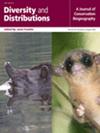Volunteers Sample Where Endangered Bumble Bees Occur: Model-Based Triage of Preferential Sampling in Multi-Species or Integrated Distribution Models
Abstract
Aim
Many broad-scale ecological inventory and monitoring efforts collect multi-species (or otherwise multivariate) data under unstructured study designs. Unstructured designs are vulnerable to preferential sampling, where residual covariance between locations selected for sampling and the response variable of interest may render predictions strongly biased.
Innovation
We extend previous work to address preferential sampling in spatial single-species distribution models to a multivariate context. Using spatially structured latent variables to approximate residual covariance between species occurrence probabilities and sampling inclusion probabilities, we present ways to account for sampling that may be preferential to varying degrees across multiple species, where (analogously) multiple datastreams might be preferential to varying degrees for a single species, or both. We use simulation to explore our proposed model and present an application that delineates the distributions of 13 bumble bee species across Wisconsin, USA and evaluates evidence for preferential sampling within 3 citizen science datastreams.
Main Conclusions
Simulation results suggest that our proposed model improves out-of-sample predictions of species occurrence or richness when the sampling design is preferential and residual covariance between sampling and species occurrence exhibits spatial structure compatible with model assumptions, reducing bias in predictions of species occurrence or richness. Empirically, volunteers appeared to sample preferentially with respect to bumble bee distributions, being more likely to sample in locations where the federally listed Bombus affinis was more likely to occur. Our approach enables practitioners a means to triage preferential sampling within increasingly popular multi-species or integrated distribution models and can be modified slightly to deal with a variety of other response variables.


 求助内容:
求助内容: 应助结果提醒方式:
应助结果提醒方式:


